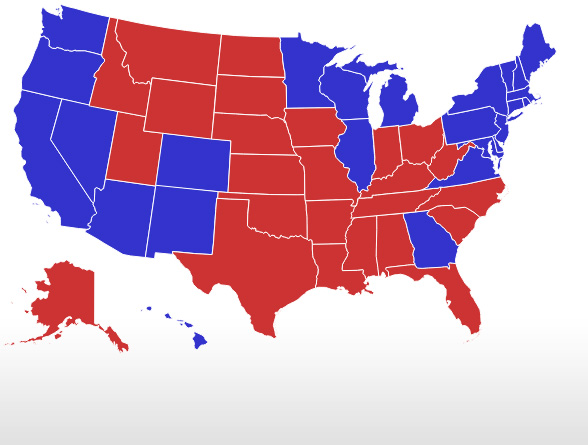Wake me when it’s over.
That’s probably how most people feel about the US presidential election right now. Biden supporters are celebrating a victory declared by the media. Trump supporters are pursuing claims of fraud in several states that could change the expected result.
The one thing that all Americans should agree on (but don’t) is that the presidential election actually takes place on 14 December. I explain why that’s true below.
The one thing all Americans certainly do agree on is that it’s time to resolve the disputes and put this election behind us once and for all. That’s a worthy wish, but it won’t happen for at least a few more weeks.
How to Survive Australia’s Biggest Recession in 90 Years. Download your free report and learn more.
Welcome to the election that just won’t end
Below is a chart showing which candidate won each state as presented by RealClearPolitics, a website the specialises in electoral news and polling data. No single source is 100% reliable, but RealClearPolitics comes closer to objectivity than sources in the mainstream media.
It’s a good starting place for analysing political outcomes. States that went for Biden are shown in blue and states that went for Trump are shown in red.
Based on this chart, the outcome of the election is cut and dried. Biden won key swing states such as Michigan, Wisconsin and Pennsylvania, and surprised many by taking formerly red states such as Georgia and Arizona. Some of these states were decided by small margins, but close doesn’t count in politics. A win is a win, and Biden won. Game over.
|
|
| Source: RealClearPolitics |
But is it over?
Biden and the media say yes, but the Trump campaign says no. What is the basis for Trump’s efforts to challenge the outcome in certain states? The bottom line is that voting was conducted fraudulently.
This arose in three ways: Not allowing Republican poll watchers to observe the count, stuffing the ballot box with illegal mail-in ballots, and rigging voting machines in certain states with computer code that either converted Trump votes to Biden or simply added Biden votes out of thin air.
The states in question are Arizona, Nevada, Georgia, Michigan, Wisconsin and Pennsylvania. If Arizona, Georgia and Pennsylvania were found to be Trump victories, that would switch 47 electoral votes from Biden to Trump, and Trump would win the Electoral College 279–259. There are other combinations of states and electoral votes that could produce a Trump victory.
What is the process by which this kind of long-shot victory for Trump could happen? And, what is the timing? The good news (if you’re sick of the infighting and just want to get this behind us) is that this will be resolved in a few weeks at most.
The state of play going forward
A brief civics lesson is in order. Most people assume the US president is elected on Election Day, which was 3 November 2020. That’s not correct.
On Election Day, voters actually vote for electors put forward by each candidate. Your ballot may say ‘Trump’ or ‘Biden’, but you’re really voting for their electors. A number of further steps are needed before the electors choose a president and that choice is confirmed.
Here are the key dates (some of which have already passed):
1–4 December 2020: States complete certification of their votes (some states completed certifications as early as 20 November). States choose their electors to vote for president and this choice is expressed in a Certificate of Ascertainment.
8 December 2020: This is the ‘safe harbour’ deadline for states where there was a dispute or contest about the election results and the choice of electors. The state governor must produce a certificate describing how the contest was resolved.
14 December 2020: The Electoral College meets (with each state delegation meeting in its own state capital and the Washington, DC electors meeting there). The Electoral College then elects the president and vice president. The result is recorded in a Certificate of the Vote.
23 December 2020: This is the deadline for each state (and DC) to deliver both the Certificates of Ascertainment and the Certificates of the Vote to designated elected officials, the US Archivist, and a US District Court judge in the district where the electors met.
6 January 2021: A Joint Session of Congress meets to open the Certificates sent by the states, count the votes and declare a winner. Vice President Mike Pence presides over this joint session in his role as president of the Senate. If one of the tickets receives 270 or more electoral votes, he is declared the winner.
20 January 2021: The newly-elected president and vice president take the oath of office. The new administration takes office at noon.
Normally this timeline is a snooze and Americans are barely aware of it until the actual inauguration on 20 January. The results of the 3 November 2020 Election Day are considered final and the new president is sworn in on 20 January 2021. Everything else is a pro forma paper chase. It may be technically required, but it happens smoothly, and no one cares.
Not this time. Stay tuned for my next edition of the Daily Reckoning Australia, where I explain why.
Regards,
 |
Jim Rickards,
Strategist, The Daily Reckoning Australia
PS: Australia’s Great COVID Recession — Learn which investments to accumulate and which ones to avoid in order to give you the best chance of preserving your wealth during the recession. Click here to learn more.



Comments